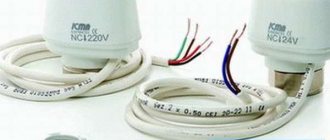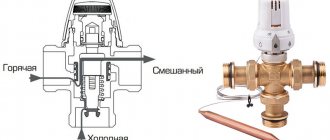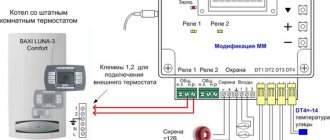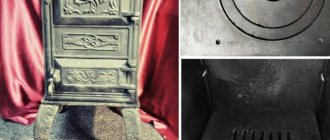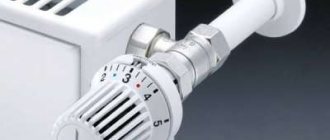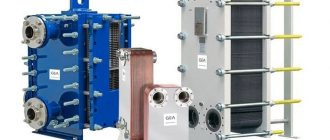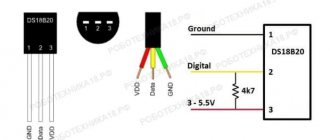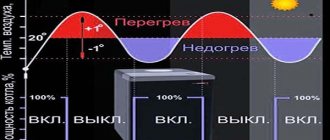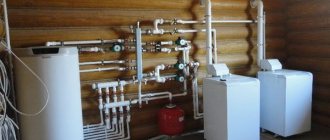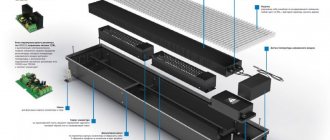A high-quality, balanced heating system not only saves fuel and maintains a comfortable heating temperature, but also helps to significantly extend the life of the heat generator by reducing the frequency of boiler starts.
A room thermostat is a smart device that allows you to regulate the operation of a heating unit in accordance with a given temperature or weather conditions outside the window. In practice, a functional thermostat, when used correctly, can save a significant amount of fuel.
Thermostat for heating boiler (thermostat): types, functions, prices
Given the rise in energy prices, the issue of energy saving is extremely pressing. That is why a large number of models of heating devices have been developed that are economical in fuel consumption. However, the equipment itself is not enough. A thermostat for a heating boiler (thermostat) will help you spend energy resources most efficiently, allowing you to control and maintain the set air temperature in a heated room.
Thermostats for boilers: photos, types of thermostats, operating principle, connection diagram.
Installation
A remote thermostat is installed in any of the living rooms, as a rule, in the coldest (usually one of the corners) or the most visited, for example, in the living room. If installed in a kitchen, hallway or boiler room, the device will not be able to ensure the correct operation of the heating system.
In order for the instrument readings to be as objective as possible, the influence of thermal interference should be minimized.
These include:
- Sun rays;
- drafts;
- thermal effects from household electrical appliances or heating radiators.
Don't forget that cold air settles down, while warm air rises to the ceiling.
Therefore, the thermostat should be placed as low as possible. You should also avoid installing it in confined spaces, such as behind a curtain, or in a narrow gap between pieces of furniture.
To know exactly where the contacts for connecting the thermostat and other equipment are located on the boiler, you should carefully study its technical data sheet and user manual. It also provides connection diagrams and recommendations that are relevant specifically for this boiler model.
Upon completion of installation and connection, the thermostat must be adjusted. The procedure is described in the instructions for the device. At this stage, the following data is entered into the thermostat memory:
- Desired temperature.
- Permissible temperature difference. If, for example, at a set temperature of 23 degrees, a difference of 2 degrees is set, then the thermostat will turn on the boiler at 22 degrees and turn off at 24.
- Response delay.
With the latter setting, the device will not react every time it, for example, briefly finds itself in a draft or something hot is passed by.
The thermostat allows you to regulate the temperature in the room. Thermostat for an infrared heater - design and connection to a heating device, as well as an overview of prices for devices.
Which wall-mounted gas boiler is better in terms of price-quality ratio, read here.
And in this topic https://microklimat.pro/otopitelnoe-oborudovanie/kotly/gruppa-bezopasnosti.html you will learn what a boiler safety group is, what functions the device performs and how to install it correctly.
Purpose of thermostats for heating boilers
To be able to control the energy consumption of heating equipment, it is equipped with special devices - thermostats. These devices allow efficient use of fuel by shutting off the equipment when the set temperature level is reached. Thermostats are used for electric boilers, gas and solid fuel boilers, as well as convectors, heaters and other heating systems.
The thermostat is capable of responding to temperature changes and turning heating equipment on and off automatically.
To achieve economical operation of the heating boiler, the thermostat turns on the equipment when the temperature drops below the set value and turns off when the set value is reached.
This method allows you to avoid unnecessary consumption of gas or electricity when, for example, some of the rooms are located on the sunny side and less heat is needed to heat them than for other rooms. On a note! Even a slight decrease in temperature within 1 degree helps reduce energy consumption by 4-6%.
In addition, using thermostats, you can set the operating mode of the heating system, in which the temperature in the absence of people in the house or at night will be 4-5°C lower. Thanks to this, it is possible to achieve savings in electricity or gas consumption of about 30%. Thus, if your heating equipment does not have such a built-in device, it would be advisable to buy a thermostat for the heating boiler. The temperature regulator will provide a solution to the problem of excessive energy consumption.
Using a thermostat, you can set different heating modes for different times.
Advantages of the device
In addition to the fact that the thermostat frees the user from worries associated with setting up the heating system, it allows you to benefit from the following:
- By turning off the boiler in a timely manner, it is possible to sharply reduce gas or electricity consumption (savings of up to 30%);
- the risk of accidents due to overheating or freezing of the system is reduced to zero.
Since the thermostat does not allow the temperature to drop too much, the heat generator always operates in a gentle mode, which significantly extends its service life.
Types of thermostats for heating boilers
Equipping heating equipment with thermostats allows you to maintain a given temperature climate in the room with an accuracy of 1 to 0.5 degrees. They control the operation of the heating system using various actuators. There are electromechanical and electronic thermostats. The design of a mechanical thermostat for a heating boiler has an on/off key and a rotary button for controlling the temperature regime.
Electronic or programmable thermostats have a more advanced structure, but are simple and easy to use. With their help, you can adjust the daily temperature cycle: in this case, the boiler will automatically switch to the set mode. Such devices can regulate both the entire heating system and individual heating blocks.
There is a classification of devices into wired and remote controlled. For the former, the connection of conductors, as well as external protection from mechanical damage, is important. The quality of the signal supplied from the boiler to the controller, notifying the entry of coolant into the circuit, depends on this. During installation, the question may arise about how to disguise the signal line so that it is invisible.
The simplest type of thermostat is mechanical.
In a wireless boiler thermostat, control occurs through the transmission of a radio signal. Such a device has two blocks, one of which is mounted in close proximity to the heating boiler, connecting to the equipment terminals. The second node is located indoors. There is a dedicated radio communication channel between the two blocks. The control unit is equipped with a display and control keyboard.
Depending on the degree of automation, thermostats can be digital or analog. The operation of digital devices is based on the signal of microcircuits, thanks to which the device can record and apply several specified modes. Analog thermostats are controlled manually using a mechanical regulator connected to a rheostat.
Thermostat device
The design of thermostats of all types and manufacturers has a general scheme. The device contains three main blocks: temperature sensor, adjustment unit, control unit. The temperature-sensitive element of the device monitors the ambient temperature level.
If the temperature changes in one direction or another, they are recorded by the sensor and transmitted in the form of electrical signals to the control unit, which converts the signal according to a given program and transmits commands to execution devices: an electromagnetic relay, a mechanical valve, a device that processes the signal.
Thermostat for a heating boiler (thermostat): which one is better to choose
Before buying a thermostat for a boiler, you need to decide on the type of device. To do this, you need to understand the fundamental difference between the models of mechanical room thermostats and electronic ones. There is an opinion that the latter are difficult to configure and they are unreliable, but this is not the case.
An electronic thermostat is more accurate and has flexible settings.
Top 4 rating according to KP
Terneo RK 32A (average price 3000 rubles)
Terneo RK 32A.
Photo: yandex.market.ru A relatively rare form factor for thermostats is implemented in the Terneo RK 32A. The device is intended for installation in electrical panels or, as it is also called, on a DIN rail. The device works with heated floors and boilers. The control here is electronic and is carried out using three buttons. But the temperature set for the boiler is visible on a very simple three-digit screen. But its readability is quite good thanks to brightness and contrast. By the way, with the help of RK 32A you can also control the heating of pipes, protecting them from freezing. This model has no remote access or programming, so the boiler can only be controlled manually.
Advantages and disadvantages
Installation in an electrical panel will be useful for someone; it works not only with boilers, but can also be used in a pipe heating system.
No programming possible.
show more
Caleo C450 (average price 1800 rubles)
Caleo C450.
Photo: yandex.market.ru An affordable heat regulator option for a warm home. The design of Caleo C450 involves surface-mounted installation. The range of adjustment of the boiler heating degree here is from 10 °C to 35 °C. The controls of this model are mechanical, but with their own specifics. It is clear that they tried to save money here, but why is there no temperature gradation around the twister, but only risks? Probably, the manufacturer was trying to save money this way. But there are two temperature sensors and a self-diagnosis mode.
Advantages and disadvantages
Inexpensive, moisture-proof
You will have to guess with the temperature when setting, narrow adjustment range for the boiler
show more
Nest Learning Thermostat 3.0 (average price 22 thousand rubles)
Nest Learning Thermostat 3.0.
Photo: yandex.market.ru A thermostat capable of working with heating boilers, which is quite indecently expensive. The functionality here is so broad that some options seem superfluous. Externally, the thermostat is a washer that is installed separately. The connection between the device and the boiler is wireless, via Wi-Fi, so Nest needs to be selected for certain models of heating equipment. You can control the regulator using a rotary ring or from a mobile application. Of course, both mode programming and remote control are present here. Unusual features include automatic shutdown if people leave the room; creating an auto-schedule based on user preferences; auto start when a person appears in the room. With the latter, a problem may arise, or rather, with the operation of the sensor - therefore the manufacturer recommends not installing the thermostat for the boiler in the far corner.
Advantages and disadvantages
An interesting solution for a “smart home” that may appeal to geeks, extensive automation
Not suitable for all heating boilers, huge cost - for this price you can buy several excellent thermostats from other manufacturers
show more
REXANT R200 (average price 2411 rubles)
REXANT R200.
Photo: yandex.market.ru A relatively affordable option for a thermostat for a boiler. Despite this, a large touch display is used here. The device is installed discreetly, in the frame of the light switch. R200 can work with both underfloor heating and an electric heating boiler, as well as infrared elements. The device measures the temperature in the room with two sensors: internal and external. There is also programming of up to 6 time periods for each day of the week. The manufacturer declared a function when the thermostat realizes that the temperature in the system is higher than the set one, after which the heating stops. It’s interesting that even though IP20 protection against dust and moisture is claimed here, users complain that the device is still afraid of water ingress. There are also defects when the device breaks down literally after six months.
Advantages and disadvantages
Touch control, dual-zone metering
Moisture protection is only on paper, there are defects
show more
The principle of operation of a mechanical thermostat for a heating boiler
In most cases, mechanical thermostats for heating boilers are used in gas installations. This is due to the fact that gas boiler manufacturers initially produce devices that are compatible specifically with mechanical models of thermostats. The design of a mechanical thermostat has a gas membrane, inside of which there is a special gas.
When the temperature deviates from the norm, the volume of gas inside the membrane changes and the mechanism for closing or opening the power supply system of the heating boiler is activated accordingly. This is a fairly simple way to control the operation of a boiler, when its operation depends on the temperature not of the coolant, but of the air in the heated room.
Using a mechanical model of a thermostat, you can set an acceptable temperature regime by turning the round button with divisions, which is connected to the membrane. Thus, the walls of the membrane approach or move away from the control device: this is how we set the temperature at which the connection or rupture of the contact will occur.
The thermostat allows you to regulate the room temperature with an accuracy of 1 degree.
On a note! The simple design of mechanical thermostats for heating boilers allows you to make the device yourself.
Among mechanical devices, Siemens room thermostats have proven themselves well. Models RAA21, RAA31 have a temperature setting range of 8-30°C. Devices with a laconic design are mounted like ordinary switches and do not violate the integrity of the interior line. Easy to install and operate. The approximate price of a room thermostat for a gas boiler is 1,500 rubles.
The advantages of mechanical thermostats include low cost, repairability and resistance to power surges. The disadvantages include the low sensitivity of the device to temperature changes. Inaccuracy may be up to 3°C.
Which thermostats are better?
If we compare built-in thermostats with remote ones, then the latter should definitely be considered more preferable. Yes, they are more expensive, but they allow you to use less gas than built-in thermostats.
The latter, as already mentioned, are somewhat delayed and that is why they cannot ensure the operation of the boiler, and therefore the gas consumption, in optimal mode. Thus, the difference in price when purchasing a remote thermostat soon pays off due to gas savings.
When choosing between digital and analog thermostats, you should accurately assess your own financial capabilities. If funds allow, it is better to purchase a digital device. Its programming function is extremely convenient.
Programmable room thermostat
For example, you can set the following settings:
- on weekdays at 7-30 am (when all household members go to work) lower the room temperature to 18 degrees;
- at 17-00 (an hour before the inhabitants of the house return) warm the room to 24 degrees;
- on weekends, maintain the temperature at 24 degrees around the clock.
Of course, buying a digital thermostat is not always advisable. If, for example, the user works at home (many today work via the Internet) and the temperature requirements remain constant throughout the day, it would be more correct to buy an analog-type device.
When using untreated water (which has not undergone the desalting procedure) as a coolant, it is better to install analog temperature sensors in the heating circuit, since the accuracy of thermistors decreases greatly when scale fouling occurs.
Advantages of electronic wireless thermostats for gas boilers
The use of programmable wireless thermostats for gas boilers makes it possible not only to control the operation of heating devices, but also to do this remotely. Electronic regulation allows you to set different operating modes of the boiler depending not only on temperature, but also on a certain time of day.
A programmable electronic thermostat allows you to set the desired heating mode for a certain period of time.
By purchasing a wireless thermostat for a gas boiler with programmable functions, you can count on significant fuel savings. The purchase of a relatively expensive device pays for itself within two heating seasons.
Modern models of thermostats are equipped with the GSM standard, which allows you to transfer information to a mobile phone via SMS messages. Considering the fact that boilers from leading manufacturers support Wi-Fi technology, and their electronic control unit is connected to a thermostat, it is possible to configure the operation of heating equipment via the Internet. Know-how in this area is the development of special applications for smartphones.
A convenient operating system, no need for wires, and automatic control of equipment are important advantages in using a wireless room thermostat for a gas boiler. You can buy devices with additional options, such as joint control of the gas burner unit, adjustment of equipment depending on the outside temperature, system diagnostics and other functions.
New generation thermostats allow you to control the room microclimate through special applications using your phone.
Among the disadvantages of programmable room thermostats, one can highlight, perhaps, the possible incompatibility of the latter with boilers, depending on their manufacturer. This problem arose due to the large number of manufacturers of electronic equipment and gas heating equipment.
On a note! Before buying a thermostat for a gas boiler, you need to inquire about the compatibility of the device with the model of gas equipment from a specialist from the selling company.
An excellent example for autonomous heating are the models of room thermostats for the Baxi gas boiler. The devices allow you to set the temperature depending on the time of day and season, and regulate the temperature in different rooms. In addition, they provide an economical operating mode for gas equipment. The approximate price of the thermostat for the Baxi heating boiler model AURATON 2030 RTH is 6,900 rubles.
The best choice
The selection of a thermostat for a heating boiler is based on the personal preferences of the room owners. When choosing, you should consider what characteristics are required when using a particular boiler.
Wired or Wireless
The communication between the control unit and the sensors and the boiler for different models is carried out wired or wirelessly. In the first case, you will need to lay a wire. The cable length reaches 20 m. This allows the control unit to be mounted at a great distance from the room in which the boiler room is installed.
Wireless thermostats for heating boilers are designed as a receiver and transmitter. A distinctive feature of products of this type is that there is no need for wiring. The transmitter signal can be received at a distance of 20-30 m. This allows you to install the control panel in any room.
Temperature setting accuracy
Depending on the design of the room thermostat, the room temperature setting differs. Inexpensive models have mechanical control. The disadvantage of cheap thermostats is the error reaches 4 degrees. In this case, the temperature adjustment step is one degree. Products with electronic control have an error of 0.5 - 0.8 degrees and an adjustment step of 0.5o. This design allows you to accurately set the required power of the boiler equipment and maintain the temperature in the room in a certain range.
Ability to set the hysteresis value
The room thermostat for a gas boiler has a difference between the switch-on and switch-off temperatures. It is necessary to maintain optimal heat levels in the room.
Hystersis principle
For mechanical products, the hysteresis value does not change and is one degree. This means that after switching off, the boiler will start working after the air temperature in the room drops by one degree. Electromechanical and electronic models have the ability to set hysteresis. The adjustment allows you to change the value up to 0.1 degrees. Thanks to this design, it is possible to constantly maintain the room temperature in the desired range.
Programmable
The function is only available for electronic or electromechanical thermostats. It is possible to program the control unit to set the temperature according to the clock. Depending on the model, thermostats are programmed for up to 7 days. This makes it possible to make the heating system with the gas boiler turned on autonomous. At a certain time, the thermostat turns on or off the boiler unit or changes the intensity of its operation. With weekly programming, gas consumption can be reduced by up to 30 percent.
Wi-fi or GSM
Thermostats with built-in wi-fi and gsm module connect to the internet. Gadgets with installed applications are used to control heating. This is how remote shutdown, connection of the boiler and adjustment of temperature indicators in the heated room are carried out. Using the GSM standard, the room thermostat transmits information about the occurrence of malfunctions in the heating system to the owner’s phone. It is possible to remotely turn on or off the gas boiler.
Safety
When choosing a thermostat for gas boiler equipment, you should pay attention to the presence of safety systems. Functions are available to prevent the circulation pump from stopping, protect against freezing or exceeding the maximum temperature in the heating system, etc. The presence of such options allows you to safely use boiler equipment in autonomous mode.
Functions of room thermostats for gas boilers
Before you buy a room thermostat for a gas boiler of one type or another, you should familiarize yourself with its functionality. It should be noted that when choosing between analog and digital models, the latter have a lot of advantages and, accordingly, their price is higher.
Installing a room thermostat for a gas boiler will help reduce fuel costs for heating the room.
However, the use of a programmable room thermostat for a heating boiler can significantly reduce the frequency of equipment switching on/off, which has a positive effect on its overall operation.
An extremely important feature of a room thermostat for a boiler is the programming function, which makes it possible to set a comfortable microclimate depending on the time of day, weather conditions and other factors. The available timer allows you to set the necessary parameters, taking into account the days of the week (working, weekends), calendar season and other settings. This is very convenient for those who have a shift work schedule or work part-time.
The main advantages of a programmable room thermostat for a gas boiler:
- remote control of the heating device;
- the “day/night” setting makes it possible to set an individual heating level taking into account a certain time of day;
- ease of control allows you to quickly reconfigure the temperature in the room;
The operating principle of a room thermostat for a gas boiler.
- the programming option makes it possible to configure the operation of the equipment taking into account weather changes;
- Due to minimal switching on/off, wear is minimized and the service life of heating equipment is extended;
- significant savings in energy consumption;
- high accuracy and reliability in operation.
On a note! By purchasing a room thermostat for a programmable boiler, you get the opportunity to control heating equipment at any time of the day, regardless of your presence in the house.
Recommendations
As a rule, manufacturers of boiler equipment offer thermostats as additional accessories, in principle, at fairly reasonable prices. In principle, these devices do not do anything supernatural, so when choosing, you should first of all pay attention to the price of the device and the presence of really useful functions in it, such as the ability to program and set temperature hysteresis and accuracy. Electronic models would be preferable, as they have more precise adjustment. It is very important to choose the correct location to install the thermostat. It should be located in a place neutral with respect to heat sources, preferably where it will not be exposed to sunlight.
It is also wrong to place it close to heating radiators - in this case it will heat up quickly and stop the boiler prematurely. The location for installing the thermostat should be selected to best match the comfortable temperature for the occupants. Recommendations for installing the room thermostat can be found in the operating instructions.
Connection diagram of the thermostat to the heating boiler
After the model is selected, the question arises of how to connect the thermostat to an electric boiler or gas heating unit. The device is connected according to the recommendations specified by the manufacturer in the technical data sheet for the equipment. You just need to find the necessary section in the documentation, which will describe the method of connecting additional devices to the boiler and provide all the required diagrams.
Connection diagram of a room thermostat to a heating boiler.
On some models of thermostats, the diagram is shown on the reverse side of the decorative cover. All modern boiler models have connection points for a thermostat, which will control the operation of the heating equipment. The device is fixed using a terminal on the boiler at the appropriate point or using a thermostat cable (included in the kit).
According to professionals, wireless room thermostats should be installed in living rooms away from existing household electrical equipment (TV, refrigerator, lamps, etc.), since proximity to the heat emitted from them can lead to incorrect operation of the device. Some recommendations for installing a wireless thermostat for a gas boiler:
- To correctly measure the room temperature, it is necessary to ensure free access of air to the thermostat;
- It is not recommended to cover the devices with pieces of furniture or heavy curtains;
- the device should be located in the coolest rooms or in living areas where residents spend the most time;
The thermostat must be installed in an open area away from heating devices.
- Avoid exposing the device to direct sunlight;
- Do not install the device near heating radiators or heaters;
- The devices must not be located in the area of drafts.
On a note! The room thermostat sensors for heating are triggered when the room temperature changes by 0.25 degrees.
How to install a thermostat
In principle, installing a thermostat is not difficult, but if you are not sure that you have the necessary skills, it is better to use the services of a specialist.
So, the first thing you need to do is open the instructions (operating manual) for the gas boiler and find the layout of the connectors on the board. On the electrical connection diagram, the location for connecting the thermostat is clearly indicated and all that remains is to remove the top cover of the boiler and the protective cover of the control board. There are usually no other jumpers on the board itself, and the thermostat connection location is indicated by the letters “Ta”.
Before carrying out work, you must make sure that the gas boiler is de-energized and there is no voltage at the terminals! Some Internet sources say that the signal voltage for connecting the thermostat from the boiler side is harmless 24 Volts - ALWAYS check!!! For example, in BAXI boilers there are exactly 220 Volts!!!
Next, according to the instructions for the thermostat, you need to connect it to the boiler board instead of a jumper and assemble everything in the reverse order. It is better to make the connection with an insulated copper cable with a cross-section of at least 0.5 mm2.
Some thermostats support the connection of both heating and heating units and there may be several outputs. Those. there will be a fundamental difference in the operation of the switch: what state will be in the initial position - normally closed or normally open. For heating installations, the connection must be made to a normally open initial state. When the temperature drops, the contacts will close and a signal will be sent to turn on the boiler (as an example, look at the connection diagram for the ZONT H-1B GSM thermostat).
Heating control using a thermostat for a gas boiler
You can control the operation of heating equipment using manual settings or using a thermostat for a gas heating boiler. I would like to note that using manual settings you can set the temperature of the coolant in the system. This operation of the equipment does not respond in any way to changes in the air temperature in the room, and if this occurs, you will have to manually reconfigure the boiler again.
You can control the operating modes of a gas heating boiler either manually or through a thermostat.
The operation of the boiler in the case of manual control is associated with frequent switching on and off of the equipment, as well as the functioning of the circulation pump, regardless of what mode the unit is in: operating or standby. This causes heating equipment to wear out quickly and does not contribute to efficient fuel consumption.
If we are talking about control using a thermostat for a gas boiler, then such a device sets the optimal mode for the unit, taking into account the air temperature in the heated room. If, for example, there is a sudden warming and the room receives additional heat from the sun's rays, the thermostat will instantly respond and give a signal to the control device to turn off the boiler.
Considering that using a thermostat (temperature regulator) for a gas boiler you can set the required temperature in the room, heating will only occur if it decreases. Thus, if the device is set to 20°C, and during the day the room has also warmed up due to solar heat or the operation of cooking appliances, the boiler will be in the standby stage for a long time.
The thermostat helps reduce heating costs by 30-40%.
In this case, fuel consumption will be significantly lower. Before you buy a thermostat for a gas heating boiler, you should ask how to properly configure the device.
How to connect and install
It is not difficult to connect a room thermostat to a gas heating boiler yourself. To do this, you must have a minimum set of working tools and adhere to the recommendations of the device manufacturer, as well as those listed in the intuitive instructions supplied with the device.
Step-by-step connection instructions using the example of the AURATON wireless thermostat, consisting of an electronic head and a standard regulator:
- fix the receiver near the heating boiler;
- install batteries in a special compartment of the regulator;
- remove the covers from the top and bottom of the thermostat being installed;
- mark the locations of the mounting holes on the wall surface;
- drill holes, insert dowels and screw the receiver with screws;
- connect heating equipment to the receiver control terminals;
- Observing safety precautions, connect the power wires to the power terminals of the receiver.
Temperature regulators that are equipped with receivers are coupled. Separately sold devices require pairing, so in this case you need to initiate by pressing the left button, which is held until the green LED flashes.
After approximately 120 seconds, the receiver automatically returns to normal operation. The button on the regulator is also pressed until the radio transmission symbol lights up. Correct completion of pairing is characterized by the absence of blinking of the green LED and the device entering operating mode.
The regulator is installed on the wall, in the presence of free circulation of air masses, away from heating devices and household appliances. The device should not be exposed to direct sunlight. If the installation rules are followed, the thermostat will work as long and reliably as possible, and will also help to significantly reduce heating costs.
Setting up a thermostat (temperature controller) for a heating boiler
After you buy a thermostat for your heating boiler and connect it to your heating equipment, you will need to configure it. Each product comes with instructions that outline how to set it up. Having carefully studied it, you can independently set the necessary mode that meets the individual level of comfort of the microclimate.
On the external panel of the device there are buttons and switches through which settings are carried out. The switches allow you to control heating and air conditioning, delay switching on (does not allow the boiler to start operating during a short-term drop in temperature, for example, a draft) and temperature deviation (if you set the fluctuation value to 1°C, switching on or off will be available when the temperature increases or decreases by 0.5 degrees).
To correctly configure the operation of the thermostat for a heating boiler, it is better to contact specialists.
Using the buttons, two modes are set: optimal and economical. Thus, during the day the temperature will be provided at an optimal value, at night the temperature will drop to a level sufficient for a pleasant sleep. This mode will allow you to significantly save on energy resources. Various models of thermostats have several set modes, one of which can be selected for use.
On a note! In rooms where children and the elderly are most often present, it is recommended not to lower the temperature below 22°C.
Connecting the thermostat to the boiler: instructions
To obtain accurate measurement results, it is important to choose the right installation location:
- Installation near windows, entrance doors, ventilation ducts, climate control equipment and other objects that can affect the air temperature at the installation site is not recommended;
- It is not recommended to install it too high, near the ceiling, or too low to the floor, since heated air masses are concentrated near the ceiling, and in the absence of a heated floor, the temperature in the lower plane of the room is noticeably lower. The optimal installation height is 1.5 meters from the floor level;
- Installation near moving objects or objects that create mechanical shocks (doors, furniture touching the wall) is not recommended;
Also note that for loads above 10 A, the device is not connected directly, but through a modular contactor.
The connection and installation algorithm is always specified in the instructions for the device. For example, let's look at how to install a mechanical Cewal RQ-10:
| Photo | Process description |
| Remove the temperature control rotator | |
| Having removed the front panel, unscrew the corresponding screws | |
| We mount the structure on the wall through the appropriate holes specified in the instructions. | |
| According to the diagram from the instructions, connect the contacts. For the Cewal RQ-10 model, this diagram is shown in the photo. | |
| Additionally. There may be a jumper between the “TA” contacts of the board of some boilers; it must be replaced with a two-core insulated cable with a conductor cross-section of 0.5-0.75 mm2. |
Most modern thermostats are powered by AA batteries, but if power from the mains is required, its organization diagram looks like this:
All modern models of thermostats are supplied with instructions with a detailed, schematic description of the installation, connection and configuration algorithm. However, this requires basic electrical skills in any case.
Thermostats for electric heating boilers: how to choose a device
In places where gas supply is not available, electric boilers are used for space heating. Among the advantages of such equipment are the absence of the need for a chimney, ease of installation, environmental friendliness, silent operation, high performance and being equipped with a control unit for automatic operation.
It is enough to install and configure the thermostat for the heating boiler and it will maintain the temperature automatically.
The disadvantages of electric heating include one, but quite significant drawback - significant electricity consumption. This results in high costs for electric heating systems. Installing a thermostat for an electric heating boiler will reduce energy costs by 20 to 30% and set an individual heating mode for each room.
As with other types of heating equipment, it is possible to use an electronic or mechanical room thermostat for electric boilers. The type of device is selected depending on what options are needed in your particular case. Mechanical models are simple and inexpensive, but can be inaccurate. Electronic programmers are accurate, multifunctional and allow the equipment to operate in an economical mode without owner intervention.
Design of a wall thermostat for an electric heating boiler.
Before buying a thermostat for an electric boiler, you need to decide on the temperature regime used and take into account the area of the heated room. It is recommended that the purchased thermostat and electric boiler be manufactured by the same manufacturer. Models produced by Baxi, Ariston, Salus Controls ltd, BOSH and others are popular.
On a note! A voltage stabilizer will help ensure uninterrupted operation of the electric boiler and electronic thermostat during possible voltage drops in the network.
How to choose a thermostat?
The choice of thermostat may be influenced by certain circumstances that have nothing to do with heating. For example, the renovation stage.
If at the time of purchasing the device you are updating the interior or planning something similar, it is advisable to purchase a remote thermostat with a wired connection: the wire can easily be laid in a hidden way.
If the renovation has already been completed, a hidden installation will be too expensive (you will have to destroy the house again), so a thermostat with radio communication will be the best choice. However, it should be taken into account that walls can sometimes interfere with the passage of the signal, so before installation it is important to check the quality of communication between the individual modules.
When choosing a device, you should pay attention to various useful options. Thermostats equipped with remote controls are very convenient to use. And for those who often experience power outages, it makes sense to purchase a model with built-in batteries or one powered by batteries.
To simplify installation and setup work, choose a thermostat of the same brand as the boiler.
Where to buy thermostats for heating boilers
You can buy thermostats for gas boilers, electric and solid fuel heating equipment at specialized points selling heating equipment, as well as on websites and online stores selling elements of heating systems. The catalogs present a huge selection of modern thermostats of various types from leading manufacturers. All devices are accompanied by a manufacturer's warranty.
The modern market offers a huge selection of thermostats, both simple and the latest models.
The product range includes wired and wireless models, mechanical and electronic thermostats for solid fuel boilers, gas, electric and diesel installations, as well as convectors, infrared heaters and underfloor heating systems. All products from the catalog have quality certificates.
You can place an order and buy a thermostat for heating using a convenient search system on the Internet resource. Here you can not only preview the functions and appearance of the devices, but also consult with experts about the compatibility of the devices with a specific type of heating equipment. Experienced managers are ready to share any necessary information regarding thermostats and their functionality.
By purchasing a thermostat through an online store, you will receive a high-quality device and qualified advice from specialists.
Another advantage of online purchasing is that it is possible to get acquainted with the cost of devices in different companies and make a comparative review of prices. Having chosen a thermostat, you can get competent advice on its installation, connection and configuration. Some companies offer device installation and setup services. All questions you are interested in can be clarified by phone numbers located in the contact section.
Programmers
These “smart” devices have a wide range of functions, which may include not only the temperature mode, but also its hourly change or programming by day of the week for a long period at once. As a rule, they have a liquid crystal display with a user-friendly interface and built-in Wi-Fi.
A programmable boiler thermostat has the following advantages:
- Day/night functions, which not only maintains an optimal microclimate at different times of the day, but also significantly saves energy resources while people sleep.
- Possibility to program the mode for a week in advance, taking into account weekdays and weekends.
- Remote control via built-in Wi-Fi allows you to change settings at your discretion at any distance, as long as there is Internet access in that location. You can use a smartphone or tablet as a control panel.
- On the market there is, for example, a programmable thermostat for a gas boiler, into which one or two SIM cards are installed, allowing you to enter the necessary parameters via a smartphone.
The disadvantage of programmers is their high cost, which is fully offset by the comfort they provide to their owners.
Prices for thermostats of different models
The cost of thermostats for heating boilers depends on the type of device, the number of supported functions and the manufacturer. The most advanced models of programmable thermostats with a large selection of settings will cost much more than models of simple mechanical devices, however, their level of accuracy is much higher.
When choosing one or another type of device, it is worth considering the level of energy saving that it can provide to the heating device and the degree of ease of control of the equipment to achieve a comfortable indoor climate. The approximate price of a mechanical thermostat for a Baxi heating boiler with a temperature setting range from 5 to 30°C and frost protection is 1,180 rubles.
It is recommended to choose a thermostat and boiler from the same manufacturer, this will ensure uninterrupted operation of the entire system.
You can buy a room thermostat for a mechanical gas boiler, model SAS816WHB-0, with a 5-minute response delay option for RUB 1,490. A special feature of this device is the ability to control not only the operation of gas heating equipment, but also the operation of the air conditioner. A room mechanical thermostat Cewal RQ10 will cost you 790 rubles.
The estimated cost of an electronic wireless thermostat for the Salus Controls 091 FLRF boiler is RUB 5,200. The functions of the device include two heating modes (economical and comfortable), setting weekly programs, three levels of temperature control, 9 heating system control programs. You can buy a thermostat for the solid fuel boiler AURATON S14, which is a multifunctional device, at a price of 6,700 rubles.
By purchasing a thermostat for a heating boiler, you can not only set a comfortable temperature for each room during the cold season, but also extend the life of your heating equipment.
Advantage of using
What benefits does the installation of such equipment provide with an autonomous heating system?
- Uniform heating of the entire area of the house or apartment. It is in such conditions that it is possible to create a healthy microclimate.
- The temperature regulator of gas boilers (or any other) provides round-the-clock automatic monitoring of its operation, thus freeing people from this process for the entire heating season. The efficiency of heating and the number of times the device is turned on/off depends on it.
- Savings when using a room thermostat range from 25% to 35% if the boiler is solid fuel, gas or electric and up to 50% when heating with diesel fuel.
- Uniform switching on/off of the boiler prolongs its service life, which is extremely important considering how much similar equipment costs on the market today.
According to their design, functionality and quality of settings, all thermostats are divided into:
- Mechanical devices in which settings are set and changed manually.
- Electronic devices have a fairly large number of functions and are controlled by a remote control.
- Programmers are the most complex in structure and “advanced” in terms of the number of settings, which can be controlled while away from home via a smartphone, tablet or computer with the Internet.
All models vary in price, which directly depends on their functionality and installation method.
How to restore boiler operation
If the equipment overheats, do not delay repairs. There are times when a gas boiler explodes, so fix the problem as soon as you notice it.
Blockage and airiness of the system
If water stagnates and does not circulate in the circuit, this leads to boiling. You can hear the liquid inside gurgling. Turn off the device and wait until the coolant cools down. Often the filters are valved on both sides so you don't have to drain all the water from the system. Turn on the taps, remove and wash the filters.
If the strainer is very clogged, dip it in a solution of citric acid. Additionally, you can clean the part with a soft brush.
Filters that are worn out and cannot be cleaned should be replaced.
An air lock slows down the movement of the fluid or stops it altogether. How to deal with this:
- Open the Mayevsky taps - they are on every radiator. Place containers under them first;
- You will hear air hissing out of the circuit. Then water can flow. Do not close the taps immediately. Wait until the liquid is drained and all the air is released;
- Repeat the procedure until the air lock is completely eliminated.
Scale deposits
Magnesium and potassium salts are deposited on boiler parts when heated above 55 degrees. Most of the scale deposits in the heat exchanger because the liquid circulates and heats up in it. As a result, the passages in the tubes narrow, the pressure decreases, and water boils in the assembly. This leads to overheating and damage to the heat exchanger.
To clean the unit, remove it. The most effective way is to connect a pump to the unit and pump it with the reagent. After this, the radiator is washed with running water, dried and installed in place.
At home, the radiator is placed in a metal container with warm water. A solution of citric acid is poured into the coil. The container is placed on the stove, where it warms up for half an hour.
To prevent scale formation, install magnetic filters. Their cassettes only need to be changed once a month, but they soften the water well.
Problems with the pump
When turning on the boiler after a long period of inactivity, you need to check the pump. Its parts could stick and the holes could become clogged. Clean and replace faulty parts.
